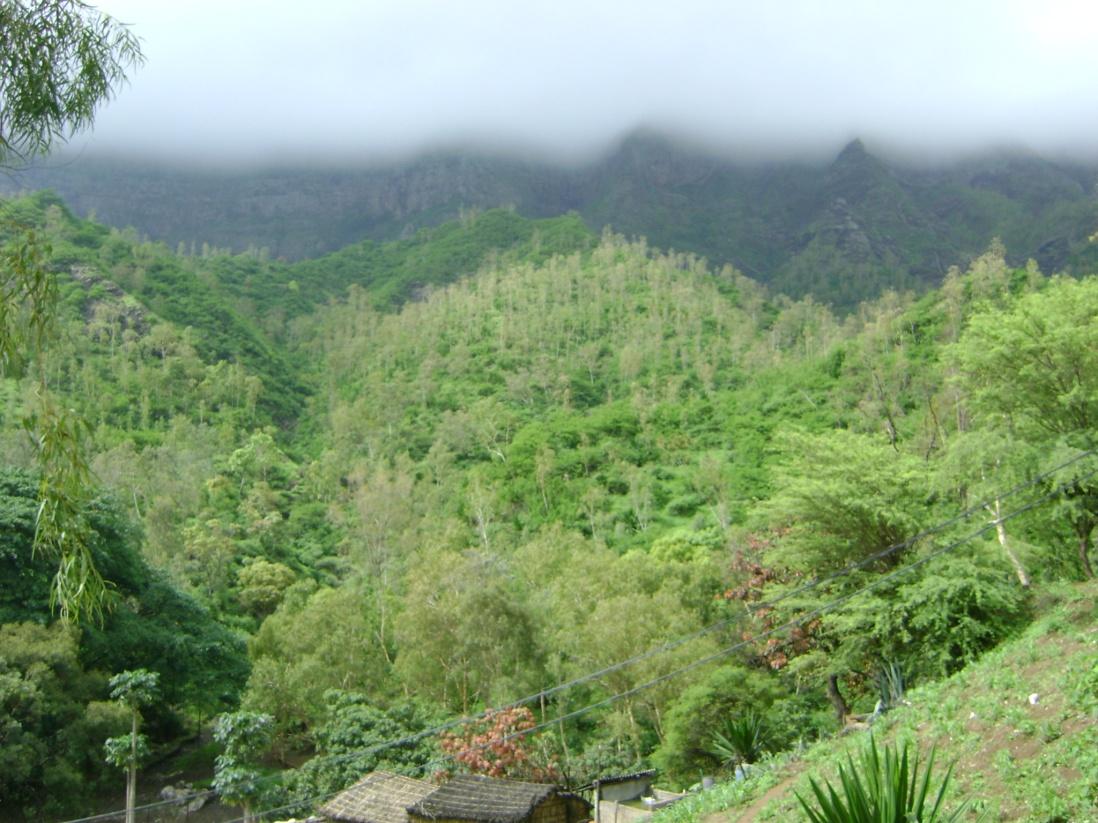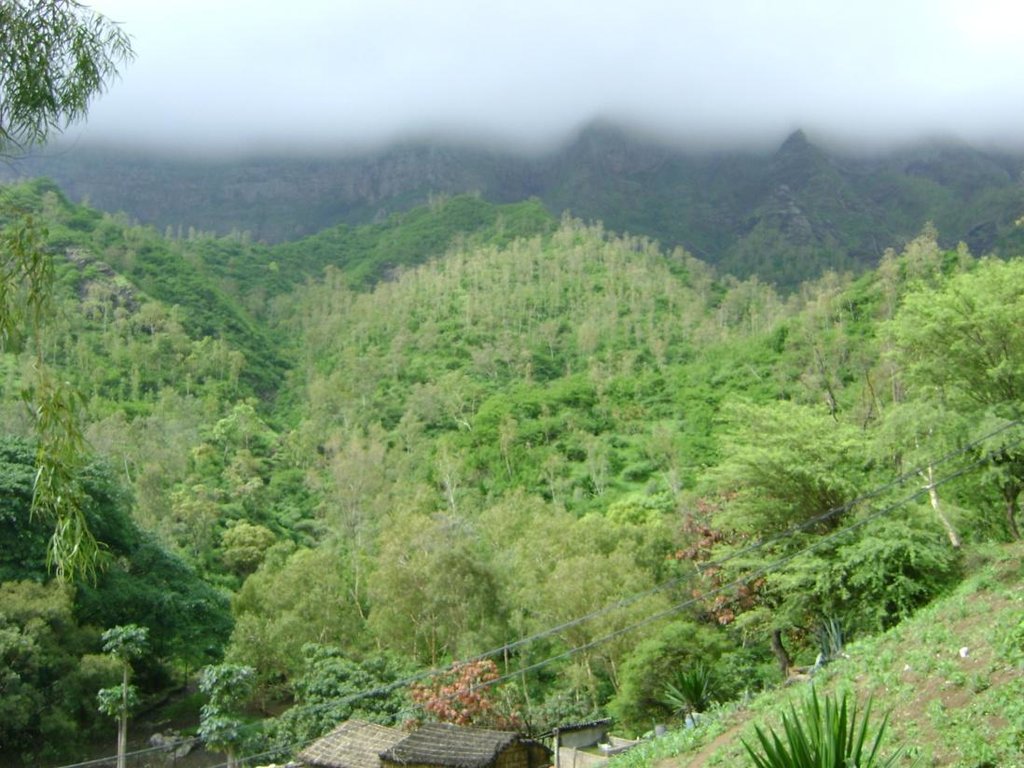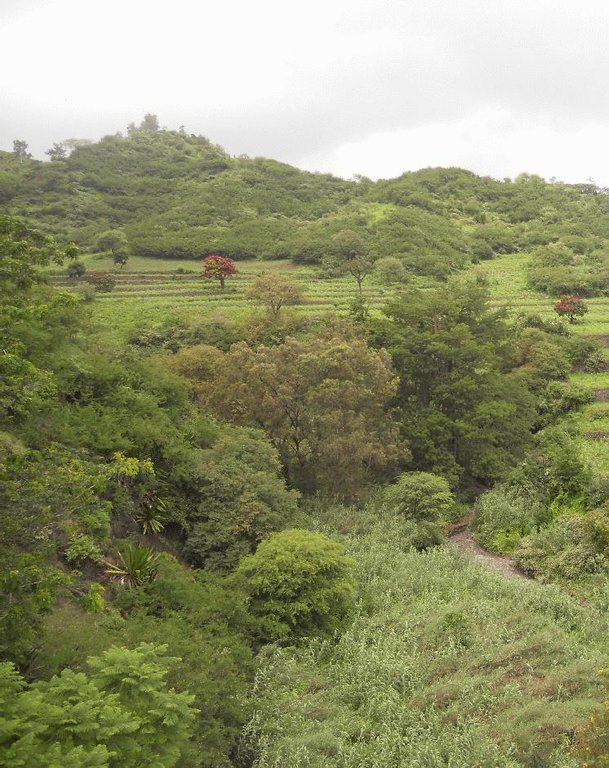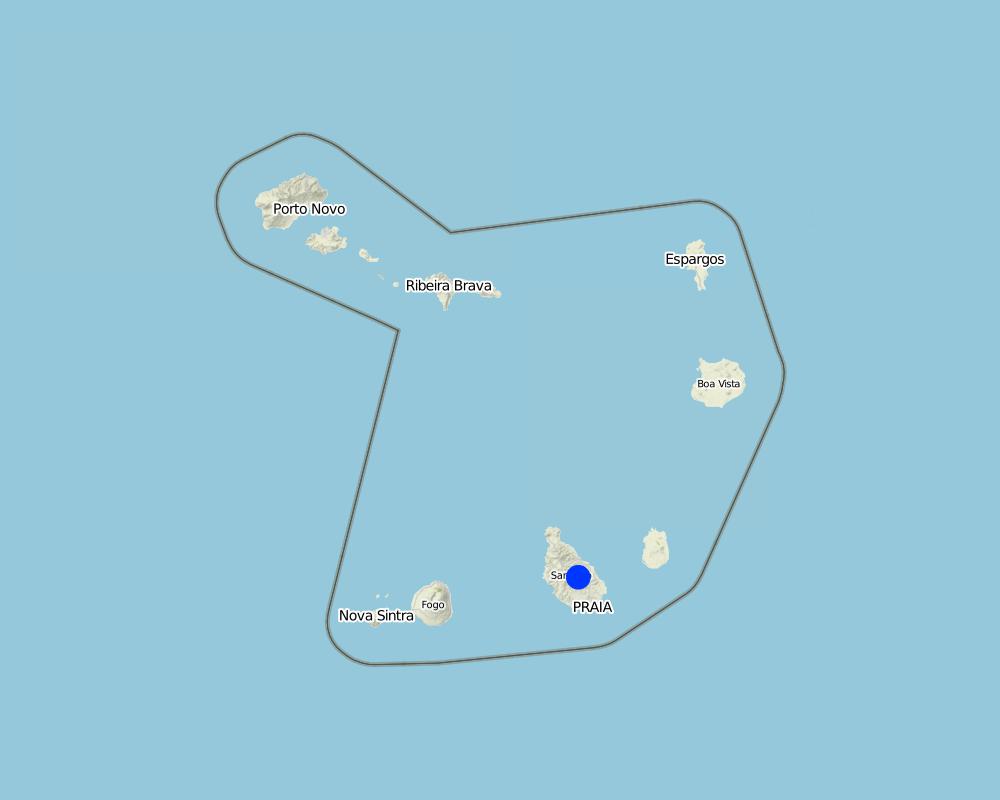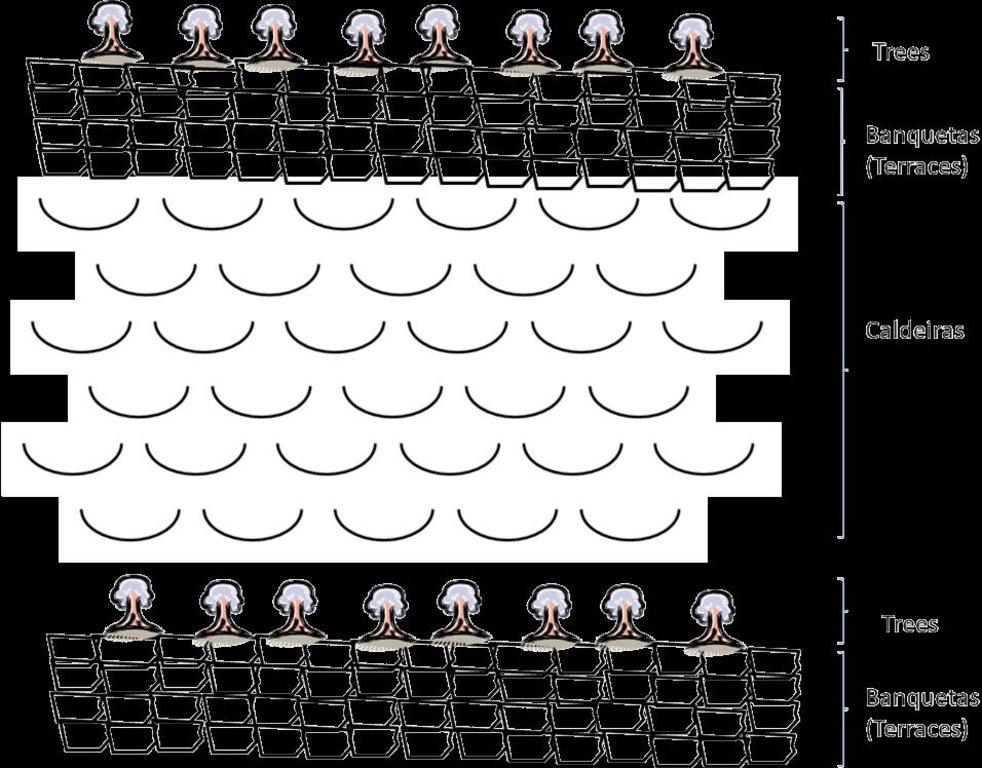Afforestation [Cabo Verde]
- Criação:
- Atualização:
- Compilador/a: Jacques Tavares
- Editor: –
- Revisores: Deborah Niggli, Alexandra Gavilano
Arborização / floresta (Portuguese)
technologies_1523 - Cabo Verde
Veja as seções
Expandir tudo Recolher tudo1. Informação geral
1.2 Detalhes do contato das pessoas capacitadas e instituições envolvidas na avaliação e documentação da tecnologia
Especialista em GST:
Varela Larissa
INIDA
Cabo Verde
Especialista em GST:
Amarós Regla
INIDA
Cabo Verde
Especialista em GST:
Bentub Jailson
INIDA
Cabo Verde
Nome do projeto que facilitou a documentação/avaliação da Tecnologia (se relevante)
DESIRE (EU-DES!RE)Nome da(s) instituição(ões) que facilitou(ram) a documentação/ avaliação da Tecnologia (se relevante)
INIDA (INIDA) - Cabo Verde1.3 Condições em relação ao uso da informação documentada através de WOCAT
O compilador e a(s) pessoa(s) capacitada(s) aceitam as condições relativas ao uso de dados documentados através do WOCAT:
Sim
1.4 Declaração de sustentabilidade da tecnologia descrita
A tecnologia descrita aqui é problemática em relação a degradação da terra de forma que não pode ser declarada uma tecnologia de gestão sustentável de terra?
Não
1.5 Referência ao(s) questionário(s) sobre abordagens GST (documentado(s) usando WOCAT)

Protection des versants [Cabo Verde]
Cette approche consiste à mettre à profit les eaux d'écoulement superficiel
- Compilador/a: Jacques Tavares
2. Descrição da tecnologia de GST
2.1 Descrição curta da tecnologia
Definição da tecnologia:
Afforestation is one of the key technologies to address the fragility of ecosystems: it provides better protection against erosion and makes better use of rainfall in order to maintain the sustainability of agricultural systems.
2.2 Descrição detalhada da tecnologia
Descrição:
Mountain forest areas are considered protective due to their role in regulating water (infiltration of storm water, regulation of surface runoff, and ground water recharge) within the watershed. The main species used are Prosopis juliflora, Parkinsonia aculeata, Jatropha curcas, Atriplex spp, Acacia holosericea, Acacia victoriae, Lantana camara and others, in arid areas and Eucalyptus camaldulensis, Grevillea robusta, Pinus and Cupressus ssp. in highland and humid areas.
Purpose of the Technology: The climatic conditions are characterized by high spatial and temporal variability of the rainfall. The rains are concentrated in two or three months (August and September or October); the highlands and the N-NE parts are wetter compared to the low lands or coastal areas, which are very dry. The average annual rainfall is about 225 mm over the whole island; it has declined since the 1960s, with negative effects on farming conditions, and water supply. However, in areas located more than 500 m above sea level and exposed to trade winds, rainfall can exceed 700 mm. About 20% of the precipitation is lost through runoff, 13% infiltrates the soil and recharges aquifers and 67% evaporates. The evaporation loss is a limiting factor for any agriculture or forestry. Therefore, it is necessary to adapt the afforestation implementation to the specific local conditions (slope, stone cover, climate, etc). To overcome and minimize the problem of water scarcity, several measures are applied: (a) caldeira or half-moon structures achieved with earth or stone; (b) contour furrows or level bench terraces with stone walls arranged along the contour; (c). small dams to protect gullies. The aim is to maximize retention of water and control surface runoff. This not only allows better infiltration of water for the tree plantations, but also protects against soil erosion and facilitates groundwater recharge.
Establishment / maintenance activities and inputs: The success of the reforestation may be indicated not only by the area covered but also by the number of introduced plants. In 1975, there were about 3,000 ha of afforested land. By 2011, there are over 90,000 ha of afforested land with almost 50 million trees. Afforestation has focused mainly on the island of Santiago and Santo Antão, (13% of the total area reforested). Nowadays, more than 20% of the country is afforested. The forest has had a great importance in the context of combating desertification, rehabilitation of vegetation cover, in meeting energy needs and forage production and in developing agrosilvopastoral systems, as well as having undoubtedly contributed to a significant modification of the landscape in Cape Verde. The afforestation activities also contributed to increase biodiversity of some species of birds, including “Galinha di mato” (Numida meleagris), “Codorniz” (Coturnix coturnix), “Passarinha” (Halcyon leucocephala) and others.
Natural / human environment: The forest species are mainly used for land protection and for production of fuel wood and coal. Because of the poor growing conditions, the forest species are not well suited to the construction industry or wood processing.
2.3 Fotos da tecnologia
2.5 País/região/locais onde a tecnologia foi aplicada e que estão cobertos nesta avaliação
País:
Cabo Verde
Região/Estado/Província:
Santiago Island, Cape Verde
Especificação adicional de localização:
Ribeira Seca
Especifique a difusão da tecnologia:
- Uniformemente difundida numa área
Se a Tecnologia estiver uniformemente distribuída por uma área, especifique a área coberta (em km2):
71,5
Comentários:
Total area covered by the SLM Technology is 71.5 km2
The forest with the greatest density of trees occupies an area of 2.51 km2 and is located in the area of higher altitude. The density decreases with decrease in altitude
Map
×2.6 Data da implementação
Caso o ano exato seja desconhecido, indique a data aproximada:
- 10-50 anos atrás
2.7 Introdução da tecnologia
Especifique como a tecnologia foi introduzida:
- através de projetos/intervenções externas
Comentários (tipos de projeto, etc.):
Before 1975, the forestry production was directed to the market of wood, after 1975 began to stock in order to protect the environment
3. Classificação da tecnologia de GST
3.1 Principal/principais finalidade(s) da tecnologia
- Reduz, previne, recupera a degradação do solo
- Preserva ecossistema
3.2 Tipo(s) atualizado(s) de uso da terra onde a tecnologia foi aplicada
Uso do solo misturado dentro da mesma unidade de terra:
Sim
Especificar o uso misto da terra (culturas/ pastoreio/ árvores):
- Silvipecuária

Pastagem
Pastagem intensiva/produção de forragem:
- Semiestabulação/sem pastagem
Tipo de animal:
- caprinos
- cows

Floresta/bosques
- Plantação de árvores, reflorestamento
Plantação de árvores, florestamento: Especificar a origem e composição das espécies:
- Variedades mistas
Tipo de plantação de árvores, florestamento:
- plantação em sistemas montanhosos tropicais - Eucalyptus spp.
- plantação de sistemas montanhosos tropicais - Pinus spp.
Tipo de árvore:
- Espécies de acácia
- Espécies de Cupressus
- Eucalipto camaldulensis
- Grevillea robusta
- Espécies de pinho
- Prosopis juliflora, Parkinsonia aculeata, Jatropha curcas, Atriplex spp, Lantana camara
Produtos e serviços:
- Conservação/proteção da natureza
Comentários:
Major land use problems (compiler’s opinion): The loss of soil by runoff, influenced by its low coverage, reducing their fertility and their thickness
Major land use problems (land users’ perception): Soil erosion by runoff, low productive soils, low organic matter, low soil cover, fertility and depth particularly in the agro-systems with rainfed agriculture.
Cut-and-carry/ zero grazing: goats/ cows
Grazingland comments: production is characterized as extensive, although made in a closed expaço
Plantation forestry: Few trees are cut, since the main objective of which is the forest canopy. The dead are removed, make's some clean and plant new trees every year.
Problems / comments regarding forest use: Before 1975, date of independence of Cape Verde, began to stock the areas discovered. The forest is more dense at high altitudes but also introduced
Forest products and services: nature conservation / protection
Future (final) land use (after implementation of SLM Technology): Mixed: Ms: Silvo-pastoralism
Type of grazing system comments: production is characterized as extensive, although made in a closed expaço
Number of growing seasons per year: 1
Longest growing period in days: 90
Longest growing period from month to month: August untill October
Livestock density : 25-50 LU /km2
The main species used are Prosopis juliflora, Parkinsonia aculeata, Jatropha curcas, Atriplex spp, Acacia holosericea, Acacia victoriae, Lantana camara and others, in arid areas and Eucalyptus camaldulensis, Grevillea robusta, Pinus and Cupressus ssp. in highland and humid areas.
3.3 O uso do solo mudou devido à implementação da Tecnologia?
O uso do solo mudou devido à implementação da Tecnologia?
- Sim (Por favor, preencha as perguntas abaixo com relação ao uso do solo antes da implementação da Tecnologia)

Outros
3.4 Abastecimento de água
Abastecimento de água para a terra na qual a tecnologia é aplicada:
- Precipitação natural
3.5 Grupo de GST ao qual pertence a tecnologia
- Gestão natural e seminatural de floresta
- Gestão de irrigação (inclusive abastecimento de água, drenagem)
3.6 Medidas de GST contendo a tecnologia

Medidas vegetativas
- V1: cobertura de árvores/arbustos

Medidas estruturais
- S2: Barragens, bancos
Comentários:
Secondary measures: structural measures
3.7 Principais tipos de degradação da terra abordados pela tecnologia

Erosão do solo pela água
- Wt: Perda do solo superficial/erosão de superfície
- Wg: Erosão por ravinas/ravinamento

Degradação biológica
- Bc: redução da cobertura vegetal
- Bh: perda dos habitats

Degradação da água
- Hg: mudança no lençol freático/aquífero
Comentários:
Secondary types of degradation addressed: Hg: change in groundwater / aquifer level
Main causes of degradation: soil management (It is cultivated maize and peanuts on land slopes very pronounced and boot up the plants by the root in end of the cycle), crop management (annual, perennial, tree/shrub) (The cleaning of the crop residues of corn is done pulling them by the root, negatively affecting soil stability), poverty / wealth (Leads sensitized peoples to advocate action against the landscape for survival of the family), education, access to knowledge and support services (Knowledge and technical training increase the options for means of survival of the community that acts on the forest, the degree of attending school is low and the illiteracy rate is 17%)
Secondary causes of degradation: overgrazing (Creation of the wild animals compact the soil, destroying the structures for the conservation of soil and water exists, and creates conflict), disturbance of water cycle (infiltration / runoff), Heavy / extreme rainfall (intensity/amounts) (Sometimes occur heavy rains intensity that associated with poor vegetation cover, increase soil erosion), governance / institutional (Lack of applicability of the laws that manage the land)
3.8 Redução, prevenção ou recuperação da degradação do solo
Especifique o objetivo da tecnologia em relação a degradação da terra:
- Recuperar/reabilitar solo severamente degradado
4. Especificações técnicas, implementação de atividades, entradas e custos
4.1 Desenho técnico da tecnologia
Especificações técnicas (relacionada ao desenho técnico):
Treatment of slope before afforestation
Technical knowledge required for field staff / advisors: moderate (It's needed sufficient knowledge to choice species according to their suitability to the natural and human environment)
Technical knowledge required for land users: low
Main technical functions: control of raindrop splash, improvement of ground cover, stabilisation of soil (eg by tree roots against land slides), increase of infiltration, increase of groundwater level / recharge of groundwater
Secondary technical functions: increase in organic matter, increase / maintain water stored in soil, reduction in wind speed
Retention/infiltration ditch/pit, sediment/sand trap
Vertical interval between structures (m): 2
Spacing between structures (m): 5
Depth of ditches/pits/dams (m): 0.2
Width of ditches/pits/dams (m): 0.8
Length of ditches/pits/dams (m): 100
Height of bunds/banks/others (m): 0.4
Width of bunds/banks/others (m): 0.4
Length of bunds/banks/others (m): 100
Construction material (earth): land from the local construction of the ditch is used in the construction of banks, that can be rein
Slope (which determines the spacing indicated above): 30 - 60%
Lateral gradient along the structure: 0%
For water harvesting: the ratio between the area where the harvested water is applied and the total area from which water is collected is: 1:3
Vegetation is used for stabilisation of structures.
Autor:
Jacques Tavares
4.3 Atividades de implantação
| Atividade | Periodicidade (estação do ano) | |
|---|---|---|
| 1. | Quantification of the area to be afforested | |
| 2. | Production of plants in nursery ( 500 - 1300 plants) | |
| 3. | Treatment of area (slope) with building terraces (15 m / person / day) | |
| 4. | Treatment of area (slope) with: Making half-moons “Caldeiras” (3 / person / day) | |
| 5. | 4.Excavating the pits (10 / person / day): 60x60x60 cm | |
| 6. | Planting (50 /person / day): 5 to 5 metres | |
| 7. | Initial maintenance (8 /persons / day) | |
| 8. | Cleaning and marking on curves level | In April |
| 9. | Construction of the retention / infiltration ditch and opening of the surface of culture | April to June |
4.4 Custos e entradas necessárias para a implantação
| Especifique a entrada | Unidade | Quantidade | Custos por unidade | Custos totais por entrada | % dos custos arcados pelos usuários da terra | |
|---|---|---|---|---|---|---|
| Mão-de-obra | Labour | ha | 1,0 | 28218,0 | 28218,0 | |
| Equipamento | Tools | ha | 1,0 | 410,0 | 410,0 | 10,0 |
| Material vegetal | Seeds | ha | 1,0 | 942,0 | 942,0 | |
| Custos totais para a implantação da tecnologia | 29570,0 | |||||
| Custos totais para o estabelecimento da Tecnologia em USD | 29570,0 | |||||
Comentários:
Duration of establishment phase: 1 month(s)
4.5 Atividades recorrentes/manutenção
| Atividade | Periodicidade/frequência | |
|---|---|---|
| 1. | forest cleaning | |
| 2. | forest cleaning | In the dry session |
4.6 Custos e entradas necessárias pata a manutenção/atividades recorrentes (por ano)
| Especifique a entrada | Unidade | Quantidade | Custos por unidade | Custos totais por entrada | % dos custos arcados pelos usuários da terra | |
|---|---|---|---|---|---|---|
| Mão-de-obra | Forest cleaning | ha | 1,0 | 142,0 | 142,0 | 52,0 |
| Custos totais para a manutenção da tecnologia | 142,0 | |||||
| Custos totais de manutenção da Tecnologia em USD | 142,0 | |||||
Comentários:
Machinery/ tools: Hoe, machete
Costs are estimated according to the time required for afforestation and the entity contracted for the implementation of the activities.
4.7 Fatores mais importantes que afetam os custos
Descreva os fatores mais determinantes que afetam os custos:
The labour affects the costs more than other factors. Paid labour is a way to achieve additional income for many people in this area. The employer (Directorate General of Agriculture, Sylviculture and Livestock of the Ministry of Rural Development) provides 90% of the cost of the equipment. The lifetime of the equipment is 10-15 years.
5. Ambiente natural e humano
5.1 Clima
Precipitação pluviométrica anual
- <250 mm
- 251-500 mm
- 501-750 mm
- 751-1.000 mm
- 1.001-1.500 mm
- 1.501-2.000 mm
- 2.001-3.000 mm
- 3.001-4.000 mm
- > 4.000 mm
Especifique a média pluviométrica anual em mm (se conhecida):
800,00
Zona agroclimática
- úmido
- Subúmido
- Semiárido
- Árido
Thermal climate class: tropics. average temperature equal to 26 º C
The exposure and altitude are factors diterminantes for agroclimatic estratização. the higher areas and targeted to the SE are more humid.
5.2 Topografia
Declividade média:
- Plano (0-2%)
- Suave ondulado (3-5%)
- Ondulado (6-10%)
- Moderadamente ondulado (11-15%)
- Forte ondulado (16-30%)
- Montanhoso (31-60%)
- Escarpado (>60%)
Formas de relevo:
- Planalto/planície
- Cumes
- Encosta de serra
- Encosta de morro
- Sopés
- Fundos de vale
Zona de altitude:
- 0-100 m s.n.m.
- 101-500 m s.n.m.
- 501-1.000 m s.n.m.
- 1.001-1.500 m s.n.m.
- 1.501-2.000 m s.n.m.
- 2.001-2.500 m s.n.m.
- 2.501-3.000 m s.n.m.
- 3.001-4.000 m s.n.m.
- > 4.000 m s.n.m.
Indique se a tecnologia é aplicada especificamente em:
- Não relevante
Comentários e outras especificações sobre a topografia:
Altitudinal zone: 100-500 m a.s.l. belongs to the stratum semi-arid sub-humid. Is part of the stratum the highest percentage of the area of the basin. 1000-1500 m a.s.l. includes mainly the cliffs and ridges.
Landforms: Also ridges and footslopes. The hazards of a convex situations does not allow its application in mountain slopes.
5.3 Solos
Profundidade do solo em média:
- Muito raso (0-20 cm)
- Raso (21-50 cm)
- Moderadamente profundo (51-80 cm)
- Profundo (81-120 cm)
- Muito profundo (>120 cm)
Textura do solo (solo superficial):
- Grosso/fino (arenoso)
- Médio (limoso, siltoso)
Matéria orgânica do solo superficial:
- Médio (1-3%)
- Baixo (<1%)
Caso disponível anexe a descrição completa do solo ou especifique as informações disponíveis, p. ex. tipo de solo, PH/acidez do solo, nitrogênio, capacidade de troca catiônica, salinidade, etc.
Soil depth on average: Very shallow is associated with the sloping hillsides used for rainfull agriculture and shaloow is found mainly in the valley bottoms of the downstream.
Soil texture (topsoil): The soil overlay mainly basaltic rocks, piroclastic, conglomerates and aluvial deposits
Soil fertility is medium - low
Soil drainage / infiltration is good - medium
Soil water storage capacity is medium - low
5.4 Disponibilidade e qualidade de água
Lençol freático:
5-50 m
Disponibilidade de água de superfície:
Precário/nenhum
Qualidade da água (não tratada):
Água potável precária (tratamento necessário)
Comentários e outras especificações sobre a qualidade e a quantidade da água:
Ground water table: In rain months, it is more superficial than in the dry months
Availability of surface water: There is some just when it rains.
Water quality (untreated): Salinization of water due to over exploitation of wells and boreholes
5.5 Biodiversidade
Diversidade de espécies:
- Médio
5.6 Características dos usuários da terra que utilizam a tecnologia
Rendimento não agrícola:
- Menos de 10% de toda renda
Nível relativo de riqueza:
- Pobre
Indivíduos ou grupos:
- Empregado (empresa, governo)
Indique outras características relevantes dos usuários da terra:
Population density: 100-200 persons/km2
Annual population growth: > 4%
and own 1% of the land (the tecnology is applyed by the state, and the state of that country is poor).
Off-farm income specification: forest production (mainly grass and wood) generate an annual income of approximately $2,500
Market orientation of production system: Mixed:Forest products are quite limited: lumber, firewood, charcoal and fodder from the pods. Firewood is the most important product but marketing is quite limited in time and space and subsistence are families who enter the forest for collection of grass and firewood. It is necessary for their survival. The state sells these products in order to finance other development projects.
5.7 Área média de terrenos utilizados pelos usuários de terrenos que aplicam a Tecnologia
- < 0,5 ha
- 0,5-1 ha
- 1-2 ha
- 2-5 ha
- 5-15 ha
- 15-50 ha
- 50-100 ha
- 100-500 ha
- 500-1.000 ha
- 1.000-10.000 ha
- > 10.000 ha
É considerado pequena, média ou grande escala (referente ao contexto local)?
- Grande escala
Comentários:
Also 50-100 ha, 100-500 ha and 100-500 ha,
The forest covers all the household
The grass production is made between the trees across the forest area if it's possible
5.8 Propriedade de terra, direitos de uso da terra e de uso da água
Propriedade da terra:
- Estado
- Indivíduo, intitulado
- Diocese
Direitos do uso da terra:
- Comunitário (organizado)
- Indivíduo
Direitos do uso da água:
- Comunitário (organizado)
5.9 Acesso a serviços e infraestrutura
Educação:
- Pobre
- Moderado
- Bom
Assistência técnica:
- Pobre
- Moderado
- Bom
Emprego (p. ex. não agrícola):
- Pobre
- Moderado
- Bom
Mercados:
- Pobre
- Moderado
- Bom
Energia:
- Pobre
- Moderado
- Bom
Vias e transporte:
- Pobre
- Moderado
- Bom
Água potável e saneamento:
- Pobre
- Moderado
- Bom
Serviços financeiros:
- Pobre
- Moderado
- Bom
6. Impactos e declarações finais
6.1 Impactos no local mostrados pela tecnologia
Impactos socioeconômicos
Produção
Produção de forragens
Qualidade da forragem
Geração de energia
Comentários/especificar:
Firewood to the community
Disponibilidade e qualidade de água
Disponibilidade de água potável
Renda e custos
Despesas com insumos agrícolas
Disparidades econômicas
Impactos socioculturais
Segurança alimentar/auto-suficiência
Comentários/especificar:
It reduces the options of land use
Oportunidades culturais
Atenuação de conflitos
Situação de grupos social e economicamente desfavorecidos
Comentários/especificar:
Any sex has the same opportunity on the assets of the forest
livelihood and human well-being
Comentários/especificar:
It improves air quality, promotes the production of endemic species and its use as medicine
Impactos ecológicos
Ciclo hídrico/escoamento
Lençol freático/aquífero
Evaporação
Solo
Umidade do solo
Cobertura do solo
Perda de solo
Matéria orgânica do solo/carbono abaixo do solo
Clima e redução de riscos de desastre
Emissão de carbono e gases de efeito estufa
Velocidade do vento
Outros impactos ecológicos
Invasive species
competition
6.2 Impactos externos mostrados pela tecnologia
Disponibilidade de água
Caudal confiável e estável em período seco
Cheias de jusante
Sedimentação a jusante
Capacidade de tamponamento/filtragem
Sedimentos transportados pelo vento
Danos em áreas vizinhas
6.3 Exposição e sensibilidade da tecnologia às mudanças climáticas graduais e extremos/desastres relacionados ao clima (conforme o ponto de vista dos usuários da terra)
Mudança climática gradual
Mudança climática gradual
| Estação do ano | aumento ou diminuição | Como a tecnologia lida com isso? | |
|---|---|---|---|
| Temperatura anual | aumento | bem |
Extremos (desastres) relacionados ao clima
Desastres meteorológicos
| Como a tecnologia lida com isso? | |
|---|---|
| Temporal local | não conhecido |
| Tempestade de vento local | não bem |
Desastres climatológicos
| Como a tecnologia lida com isso? | |
|---|---|
| Seca | não bem |
Desastres hidrológicos
| Como a tecnologia lida com isso? | |
|---|---|
| Inundação geral (rio) | não conhecido |
Outras consequências relacionadas ao clima
Outras consequências relacionadas ao clima
| Como a tecnologia lida com isso? | |
|---|---|
| Período de crescimento reduzido | bem |
Comentários:
Tree species more tolerant of the climatic factors can be used, whilst retaining all the benefits that the existing species provide
6.4 Análise do custo-benefício
Como os benefícios se comparam aos custos de implantação (do ponto de vista dos usuários da terra)?
Retornos a curto prazo:
negativo
Retornos a longo prazo:
positivo
Como os benefícios se comparam aos custos recorrentes/de manutenção(do ponto de vista dos usuários da terra)?
Retornos a curto prazo:
neutro/balanceado
Retornos a longo prazo:
muito positivo
Comentários:
The high costs are associated with its implementation; afterwards they are significantly reduced and the technology builds up the benefits.
6.5 Adoção da tecnologia
Se disponível, determine a quantidade (número de unidades familiares e/ou área abordada):
None. It's a project of the government
Comentários:
Comments on acceptance with external material support: Only the state has implemented this technology, because it changes the use of land and, without any subsidies, other land users are not encouraged to agree to it.
There is a moderate trend towards spontaneous adoption of the Technology
Comments on adoption trend: there is a continuing campaign of afforestation of state land. There are voluntary associations working in this technology for a better environment
6.7 Pontos fortes/vantagens/oportunidades da tecnologia
| Pontos fortes/vantagens/oportunidades na visão do usuário da terra |
|---|
|
Production of firewood and grass How can they be sustained / enhanced? make more forest operations such as pruning or cutting of new seedlings |
|
Protection of soil How can they be sustained / enhanced? strengthen maintenance operations |
| Pontos fortes/vantagens/oportunidades na visão do compilador ou de outra pessoa capacitada |
|---|
|
Increases the quality of the landscape and reduces the loss of soil by runoff How can they be sustained / enhanced? increasing the tree cover in areas with low coverage |
|
Encourages the production of livestock, and fuel wood How can they be sustained / enhanced? integrate the community in managing the forest, and manage it in a sustainable way. |
6.8 Pontos fracos, desvantagens/riscos da tecnologia e formas de superá-los
| Pontos fracos/desvantagens/riscos na visão do usuário da terra | Como eles podem ser superados? |
|---|---|
| impossibility of farming in the forest lands | off-farm income creation to compensate |
| Lack of involvement of farmers in the management of forest areas | capacity building of land users in forest management strategies, elaboration of contracts between State and land users for the management of forest perimeters |
| Pontos fracos/vantagens/riscos na visão do compilador ou de outra pessoa capacitada | Como eles podem ser superados? |
|---|---|
| Reduces the percentage of land for agricultural production | increase productivity in cultivated land and reduce the need for the use of forest land, and implement new production technologies such as greenhouses |
7. Referências e links
7.1 Métodos/fontes de informação
7.2 Referências às publicações disponíveis
Título, autor, ano, ISBN:
Desertification at the Santiago Island, DESIRE, 2008
Título, autor, ano, ISBN:
Relatório de avaliação inicial do impacto das realizações de conservação de solos e água em 1993 do projecto WDP, WDP project, 1995
Título, autor, ano, ISBN:
www.ine.cv: Survey of family income and expenditure, INE, 2002
Título, autor, ano, ISBN:
OCDE, CILSS, 1982. Análise do Sector Florestal e Propostas para Cabo Verde. Sahel D (82) 179
Disponível de onde? Custos?
Club do Sahel, pp 203.
Título, autor, ano, ISBN:
MAAA/DGASP, 1996. Rapport de pays pour la Conférence Technique Internationale de la FAO sur les Ressources Phytogénétiques, Leipzig, 1996, pp 38.
Disponível de onde? Custos?
Leipzig, 1996, pp 38.
Links e módulos
Expandir tudo Recolher tudoLinks

Protection des versants [Cabo Verde]
Cette approche consiste à mettre à profit les eaux d'écoulement superficiel
- Compilador/a: Jacques Tavares
Módulos
Não há módulos


